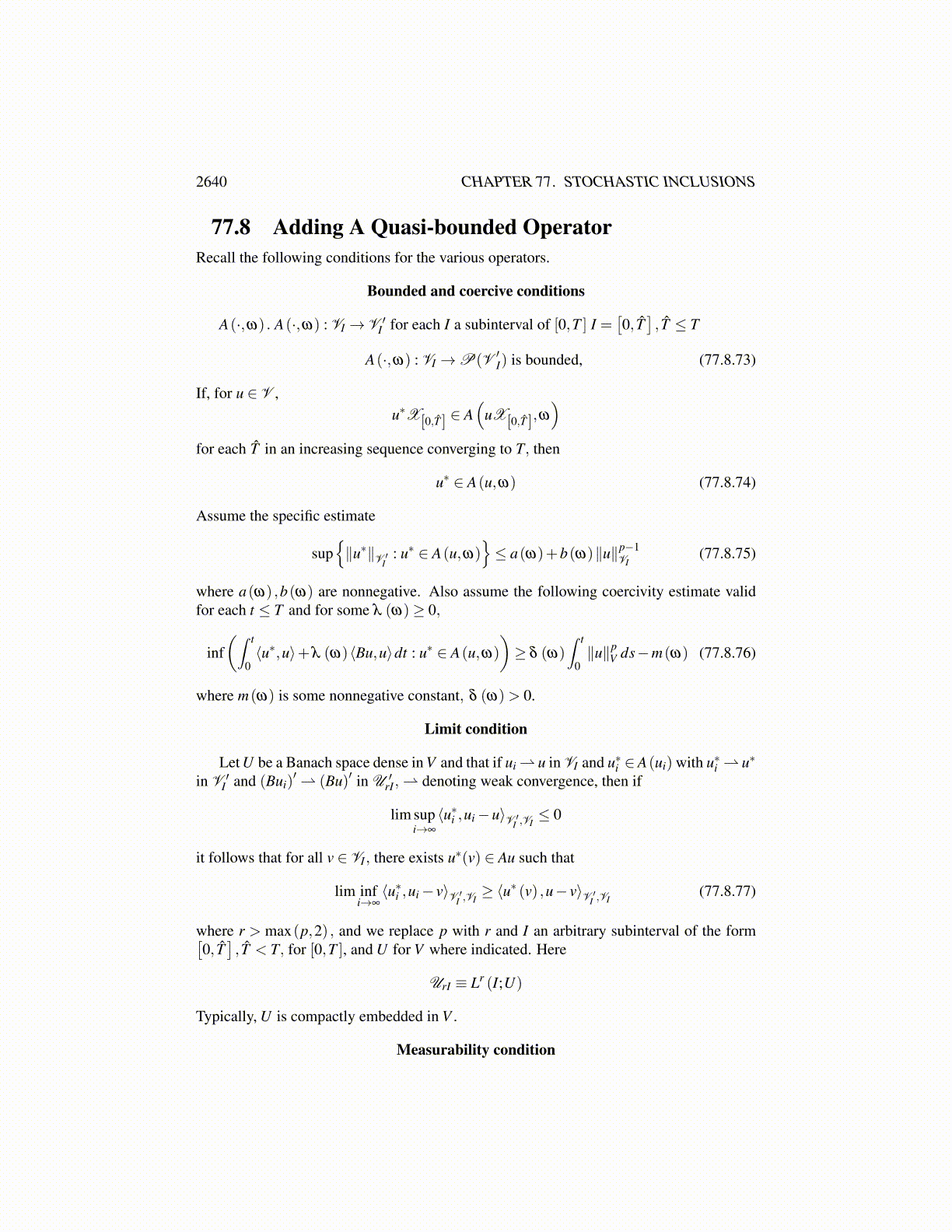
2640 CHAPTER 77. STOCHASTIC INCLUSIONS
it follows that for all v ∈ VI , there exists u∗(v) ∈ Au such that
lim infi→∞⟨u∗i ,ui− v⟩V ′I ,VI
≥ ⟨u∗ (v) ,u− v⟩V ′I ,VI(77.7.71)
where r > max(p̂,2) , and we replace p with r and I an arbitrary subinterval of the form[0, T̂], T̂ < T, for [0,T ], and U for V where indicated. Here
UrI ≡ Lr (I;U)
The theorem to be shown is the following.
Theorem 77.7.3 Assume the above conditions, 77.7.66, 77.7.67, 77.7.68, 77.7.70, 77.7.71,and the Condition 77.7.2. Let u0 be F0 measurable and ω → B(ω) also F0 measurableand (t,ω)→X[0,t] (t) f (t,ω) is B ([0, t])×Ft product measurable into V ′ for each t. Alsoassume that for each ω, there is at most one solution to the evolution equation
(B(ω)u(·,ω))(t)−B(ω)u0 (ω)+∫ t
0u∗ (·,ω)ds =
∫ t
0f (s,ω)ds,
u∗ (·,ω) ∈ A(u(·,ω) ,ω)
for t ∈[0, T̂]
for each T̂ ≤ T . Then there exists a unique solution (u(·,ω) ,u∗ (·,ω))in V ×V ′ to the above integral equation for each ω. This solution satisfies (t,ω) →(u(t,ω) ,u∗ (t,ω)) is progressively measurable into V ×V ′.
Proof: Let T denote subsets of (0,T ] which contain T such that for S ∈ T , thereexists a solution uS for each ω to the above integral equation on [0,T ] such that (t,ω)→X[0,s] (t)uS (t,ω) is B ([0,s])×Fs measurable for each s ∈ S. Then {T} ∈ T . If S,S′ arein T , then S ≤ S′ will mean that S ⊆ S′ and also uS (t,ω) = uS′ (t,ω) in V for all t ∈ S,similar for u∗S and u∗S′ . Note that equality must hold in V by uniqueness. Now let C denotea maximal chain. Is ∪C ≡ S∞ all of (0,T ]? What is uS∞
? Define uS∞(t,ω) the common
value of uS (t,ω) for all S in C , which contain t ∈ S∞. If s ∈ S∞, then it is in some S ∈ Cand so the product measurability condition holds for this s. Thus S∞ is a maximal elementof the partially ordered set. Is S∞ all of (0,T ]? Suppose ŝ /∈ S∞,T > ŝ > 0.
From Theorem 77.5.6 there exists a solution to the integral equation on [0, ŝ] calledu1 such that (t,ω)→ u1 (t,ω) is B ([0, ŝ])×Fŝ measurable, similar for u∗1. By the sametheorem, there is a solution on [0,T ], u2 which is B ([0,T ])×FT measurable. Now byuniqueness, u2 (·,ω) = u1 (·,ω) in V[0,ŝ], similar for u∗i . Therefore, no harm is done in re-defining u2 on [0, ŝ] so that u2 (t,ω) = u1 (t,ω) for all t ∈ [0, ŝ] , similar for u∗. Denote thesefunctions as û, û∗. By uniqueness, uS∞
(·,ω) = û(·,ω) in Lp ([0, ŝ] ,V ). Thus no harm isdone by re-defining û(s,ω) to equal uS∞
(s,ω) for s < ŝ and û(ŝ,ω) at ŝ. As to s > ŝ alsore define û(s,ω)≡ uS∞
(s,ω) for such s. By uniqueness, the two are equal in V[ŝ,T ] and sono change occurs in the solution of the integral equation. Now S∞ was not maximal afterall. S∞∪{ŝ} is larger. This contradiction shows that in fact, S∞ = (0,T ].
Theorem 77.7.4 Assume the above conditions, 77.7.66, 77.7.67, 77.7.68, 77.7.70, 77.7.71,and the Condition 77.7.2. Let u0 be F0 measurable and ω → B(ω) also F0 measurableand (t,ω)→X[0,t] (t) f (t,ω) is B ([0, t])×Ft product measurable into V ′ for each t.
B(ω) = k (ω)B, k (ω)≥ 0,k measurable.